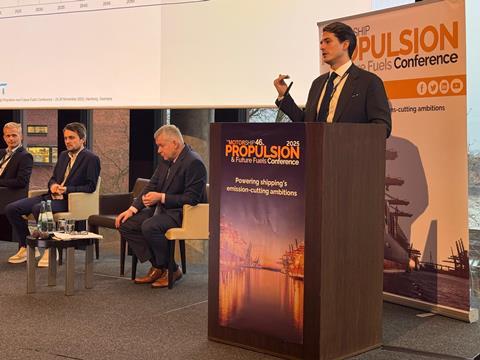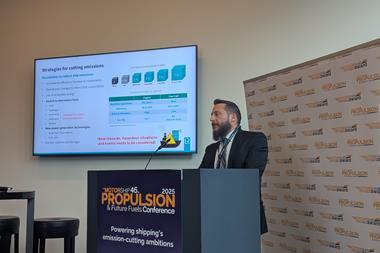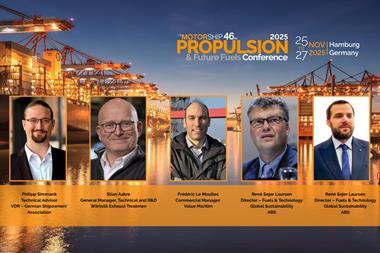Can Murtzaoglu of GTT presented the company’s current work on LNG containment technology

At this year’s Propulsion and Future Fuels event in Hamburg, Can Murtzaoglu of GTT presented the company’s current work on LNG containment technology and its perspective on LNG and bio-LNG as practical pathways for decarbonising deep-sea shipping.
He outlined GTT’s long-standing position in the LNG market, with membrane systems now installed on around 85% of the global LNG carrier fleet and applied increasingly to LNG-fuelled container ships, bunkering vessels and cruise ships. Murtzaoglu explained how the Mark III membrane system, originally developed for LNG carriers, has proven ideal for propulsion applications because of its robustness, thermal performance and flexibility, as shown in impact-resilience tests carried out with the Technical University of Hamburg. The tanks are already compatible with methanol and ammonia, giving owners fuel flexibility and reducing the risk of stranded assets.
He emphasised that, when compared with methanol and ammonia on parameters such as energy density, infrastructure readiness, safety and cost, LNG is the only fuel that is scalable today and compliant with regulatory trajectories through to 2037. By blending with bio-LNG, LNG-fuelled vessels can extend their compliance even further. He contrasted the land requirements for biofuel production and noted that supplying sufficient biodiesel for shipping in 2035 would require land equal to 60% of Europe, whereas the bio-LNG pathway would require only a fraction of that. GTT’s growing project base includes more than 120 LNG-fuelled vessels across all segments, including container ships and cruise vessels, where membrane tanks allow either significantly increased fuel capacity or major space savings, translating into strong revenue benefits. Although membrane tanks have a higher initial cost, the return on investment for cruise vessels can be achieved within 1 to 1.5 years.
Murtzaoglu introduced GTT’s newest design developments, including the cubic, chamfer-free tank optimised for container vessels, which simplifies shipyard construction, reduces boil-off and increases capacity. He also highlighted advances in boil-off gas management: raising tank pressure from 0.7 to 1.0 barg can double holding time, and the GTT Recycool recondenser, already installed or ordered for several vessels, supports MEGI engines while achieving almost no methane slip. He concluded that LNG offers an immediate and realistic decarbonisation route, with bio-LNG providing the long-term pathway to carbon neutrality and beyond.
In a separate presentation, Henning Dicks, managing partner of agriportance, provided a market-based overview of biomethane and bio-LNG in Europe and explained why shipping is becoming a key offtake sector. Agriportance specialises in certification, greenhouse-gas accounting and digital matchmaking between producers and buyers of biomethane, liquefied CO₂ and bio-LNG. Dicks outlined the rapid growth of biomethane production across Europe, rising from around 200 plants in 2011 to more than 1,600 plants today, with major contributions from Germany, France, Denmark, Italy, the UK and the Netherlands, and strong new development in Spain and Eastern Europe. Total production now exceeds 70 TWh, a scale that brings the sector close to the expected LNG demand from shipping, which could reach 100 TWh by 2030.
Dicks explained the importance of understanding subsidised and unsubsidised biomethane, as FuelEU Maritime allows the use of subsidised volumes, making them attractive to shipowners. Countries such as Denmark and France supply large volumes of competitively priced, subsidised biomethane that can be liquefied into bio-LNG. The regulatory shift brought by FuelEU Maritime in January 2025 has sharply increased interest in bio-LNG, since it enables shipowners to meet tightening greenhouse-gas intensity targets. He noted that bio-LNG can deliver net-negative well-to-wake emissions when produced from manure or waste streams and when CO₂ is captured or utilised. These negative carbon-intensity values create over-compliance opportunities and strong economic incentives for existing LNG-fuelled vessels as well as newbuilds.
He described how carbon-intensity scores are calculated across the value chain, with emissions associated with feedstock, processing and distribution raising the CI value, while manure management credits and CO₂ capture significantly reduce it. This is why manure-based bio-LNG can reach –100 gCO₂eq/MJ and waste-based streams around –50 gCO₂eq/MJ. Dicks also showed how prices for different CI grades developed throughout 2024, rising sharply as the market recognised the compliance and ETS benefits of bio-LNG. Prices have since stabilised, and all CI bands—from +5 gCO₂eq/MJ to strongly negative values—can be viable depending on a vessel’s compliance strategy. He concluded that bio-LNG is emerging as a central decarbonisation option for shipping, combining availability, infrastructure compatibility and the ability to deliver genuine net-negative emissions.
Together, the two presentations demonstrated that LNG provides the technical and operational foundation for low-carbon propulsion today, while bio-LNG offers the scalable, compliance-driven and increasingly economic route toward deep decarbonisation in the maritime sector.








